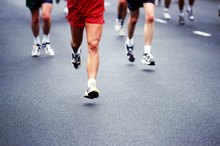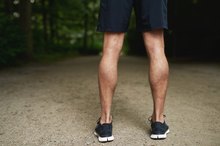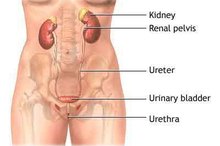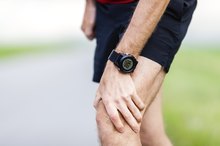How to Run With a Pulled Hamstring
Your hamstrings factor heavily into the motion used to propel yourself while running. The physiology of taking a stride and swinging the leg through for another stride combined with the impact of each foot strike places tremendous strain on all the muscles of the legs. Due to the physical demands of the activity, running is not recommended with a pulled hamstring until you reach a full recovery from the injury.
Extent of Injury
The American Academy of Orthopaedic Surgeons says a hamstring pull or strain occurs when the major muscle in the back of the thigh is torn or stretched. A mild strain may be no more than a slight pull causing stiffness, but a more severe strain can mean tearing of the muscle or possible complete rupture of the tissue.
Hamstrings and Running
Stretching Exercises for ACL Injuries
Learn More
A study by Elizabeth Chumanov appearing in the March 2011 issue of "Medicine & Science in Sports & Exercise" explains that the hamstrings are most active in the swing phase of the gait cycle as your leg leaves the ground and strides forward for the next step. The study also concludes that increased speed also increases the stress load on the hamstring. Based on this information, there is little or no way to avoid engaging the hamstrings while running. Therefore, running with a pulled hamstring may only exacerbate the existing injury and push it to tear or rupture.
- A study by Elizabeth Chumanov appearing in the March 2011 issue of "Medicine & Science in Sports & Exercise" explains that the hamstrings are most active in the swing phase of the gait cycle as your leg leaves the ground and strides forward for the next step.
Treatment and Recovery
Medline Plus explains that the extent of recovery time depends on the severity of the pull. A mild pull can result in pain and stiffness for a few days. A more severe pull can cause pain for up to two weeks. The first step to recovery is rest which requires you cease any activity that strains the injure muscle further including running. Mild strains can recover with rest, ice, compression, elevation and over-the-counter anti-inflammatory medication. When experiencing a hamstring pull, be sure to consult your health care professional for an accurate diagnosis and plan for recovery.
- Medline Plus explains that the extent of recovery time depends on the severity of the pull.
- A more severe pull can cause pain for up to two weeks.
Related Articles
References
- OrthoInfo: Sprain and Strains – What’s the Difference?
- Medicine & Science in Sports & Exercise: Hamstring Muscultendon Dynamics during Stance and Swing Phase of High-Speed Running
- Medline Plus: Hamstring Strain – aftercare
- Ernlund L, Vieira LA. Hamstring injuries: update article. Rev Bras Ortop. 2017;52(4):373–382. Published 2017 Aug 1. doi:10.1016/j.rboe.2017.05.005
- Kilcoyne KG, Dickens JF, Keblish D, Rue JP, Chronister R. Outcome of Grade I and II Hamstring Injuries in Intercollegiate Athletes: A Novel Rehabilitation Protocol. Sports Health. 2011;3(6):528–533.
- Schmitt B, Tim T, McHugh M. Hamstring injury rehabilitation and prevention of reinjury using lengthened state eccentric training: a new concept. Int J Sports Phys Ther. 2012;7(3):333–341.
- Mendiguchia J, Alentorn-geli E, Brughelli M. Hamstring strain injuries: are we heading in the right direction?. Br J Sports Med. 2012;46(2):81-5. doi:10.1136/bjsm.2010.081695
- Guillodo Y, Here-Dorignac C, Thoribé B, et al. Clinical predictors of time to return to competition following hamstring injuries. Muscles Ligaments Tendons J. 2014;4(3):386–390. Published 2014 Nov 17.
- Liu H, Garrett WE, Moorman CT, Yu B. Injury rate, mechanism, and risk factors of hamstring strain injuries in sports: A review of the literature. Journal of Sport and Health Science. 2012;1(2):92-101.
- Erickson LN, Sherry MA. Rehabilitation and return to sport after hamstring strain injury. J Sport Health Sci. 2017;6(3):262–270. doi:10.1016/j.jshs.2017.04.001
- Bourne, MN et al. "Eccentric knee flexor strength and risk of hamstring injuries in rugby union." Am J Sports Med. 2015 Nov;43(11): 2663-70.
- Goosens, EW et al. "Lower eccentric hamstring strength and single leg hop for distance predict hamstring injury in PETE students." Euro J of Sport Sci. 2015 15(5): 436-42.
- Sherry, MA and Best, TM. "A Comaprison of 2 rehabilitation programs for treating acute hamstring strains." JOSPT, 2004; 34(3):116-125.
Writer Bio
Tim Petrie is a Physical Therapist and an Orthopedic Certified Specialist working in Milwaukee, Wisc. When he isn't working, he loves distance running, Packers football, and traveling with his wife and his energetic kids.









